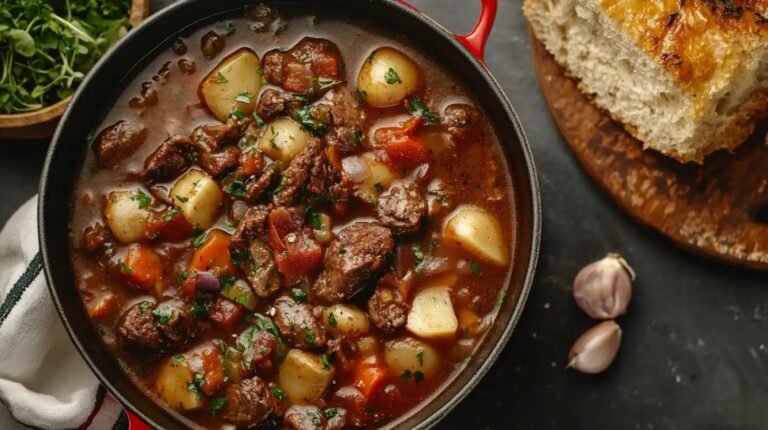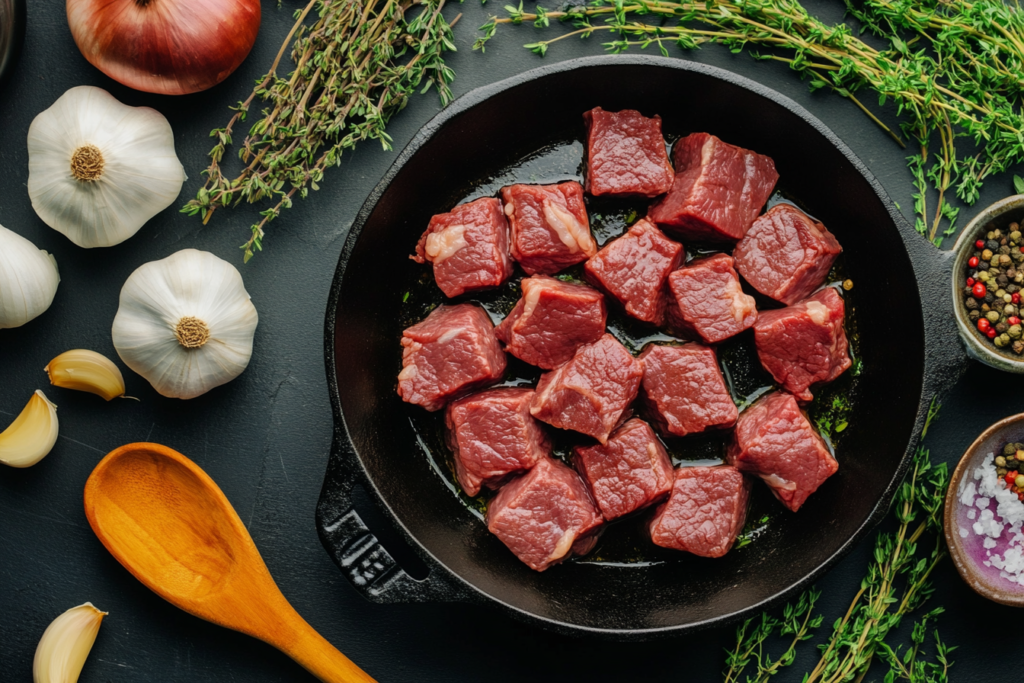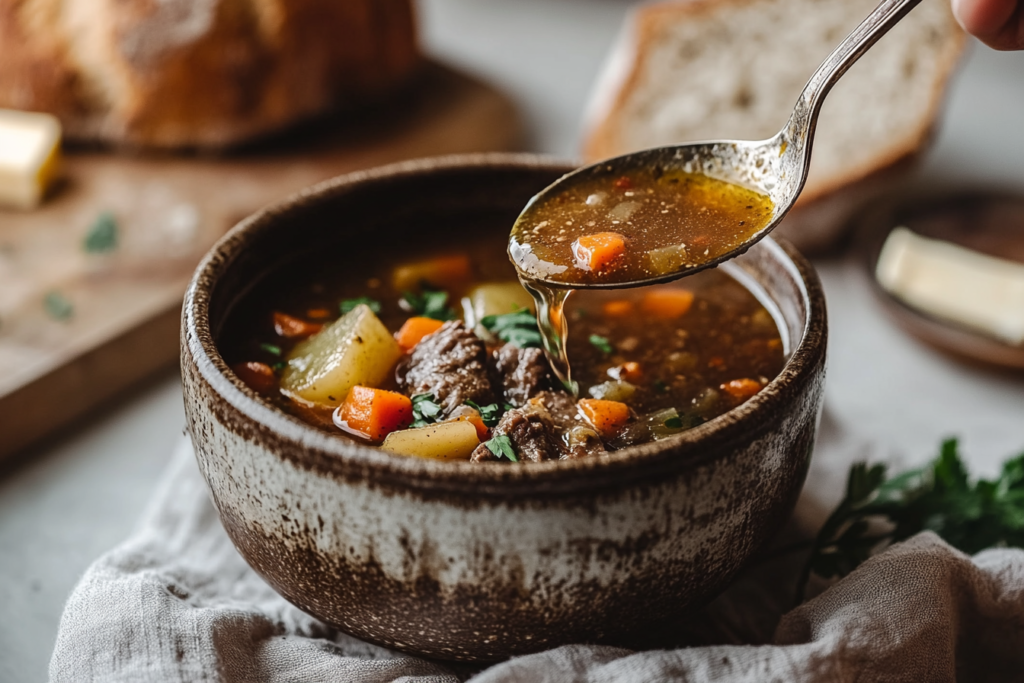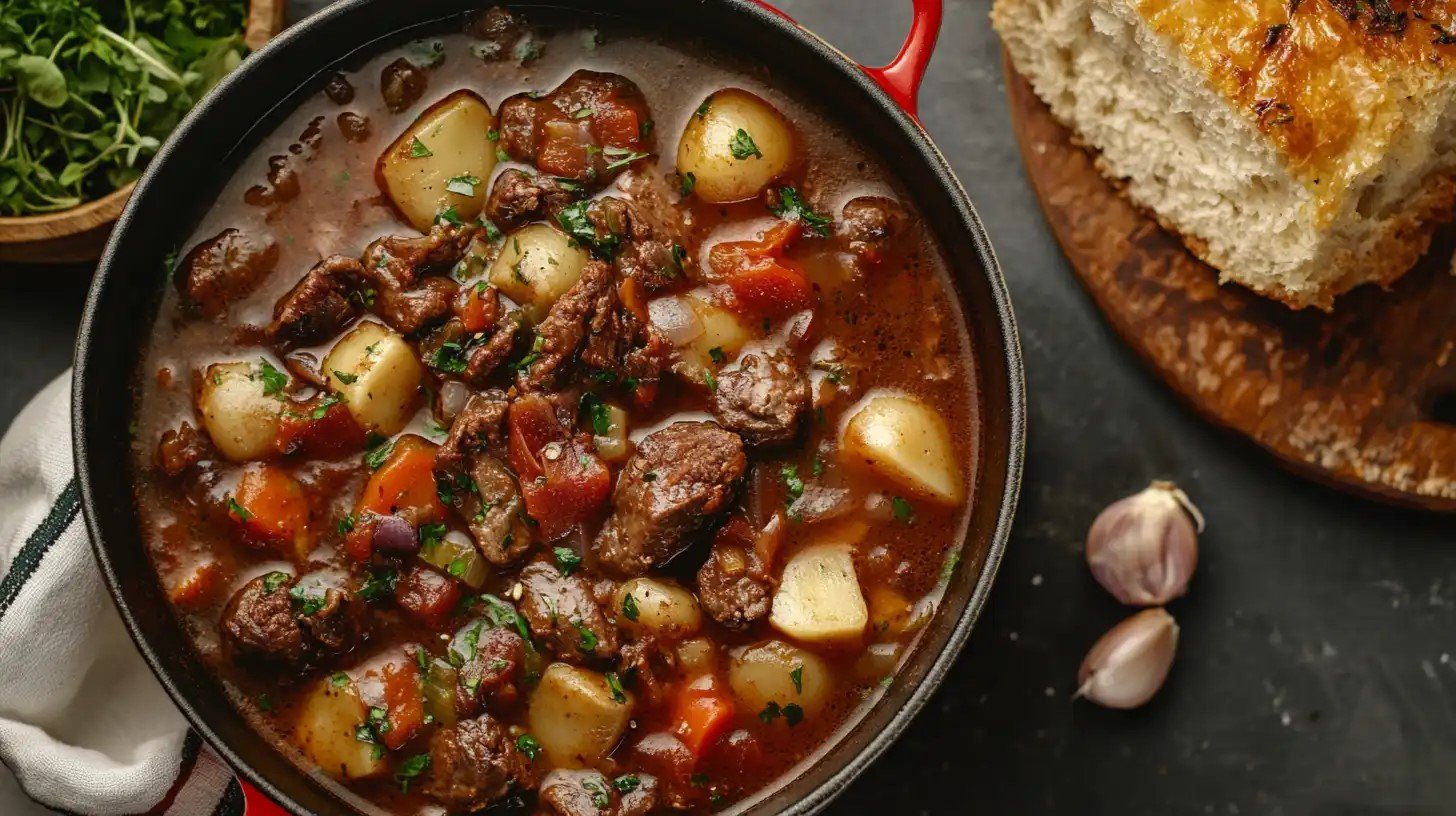This old fashioned vegetable beef soup recipe offers comforting flavors, tender beef, and hearty vegetables, perfect for a warm family meal.
Introduction
This old fashioned vegetable beef soup recipe holds a special place in many American kitchens. Basically, it brings back memories of cozy family dinners and cherished traditions. Comparatively, it stands out for its comforting qualities and hearty nourishment. Indeed, it features tender chunks of beef, garden-fresh vegetables, and a rich broth. Moreover, it warms you from the inside out. Undoubtedly, this soup remains a time-tested favorite. Accordingly, its flavors transport you to simpler days. Furthermore, it invites you to savor every spoonful. Thus, this classic soup offers a reliable choice for family meals. Eventually, you may adapt it to personal tastes by adjusting ingredients. Consequently, you end up with a versatile recipe that suits any season. Ultimately, it brings loved ones together around the table.
Print
Old Fashioned Vegetable Beef Soup Recipe for Cozy Meals
A hearty and nostalgic vegetable beef soup made with tender beef chunks, classic vegetables, and savory broth—perfect for chilly evenings or family dinners.
- Total Time: 2 hours 15 minutes
- Yield: 6 servings 1x
Ingredients
1.5 lbs chuck roast or stew meat, cubed
2 tablespoons olive oil
1 large onion, diced
3 cloves garlic, minced
3 carrots, sliced
2 celery stalks, chopped
2 potatoes, cubed
1 (14.5 oz) can diced tomatoes
6 cups beef broth
1 cup green beans (optional)
1 cup corn kernels (optional)
1 bay leaf
1 teaspoon dried thyme
Salt and pepper to taste
Fresh parsley for garnish
Instructions
1. Brown the beef in olive oil over medium heat until caramelized.
2. Remove beef and sauté onion and garlic in the same pot.
3. Add carrots, celery, and potatoes; cook for 5 minutes.
4. Return beef to pot and pour in diced tomatoes and broth.
5. Add bay leaf, thyme, salt, and pepper; bring to a boil.
6. Lower heat and simmer for 1.5 to 2 hours until beef is tender.
7. Add green beans and corn in the last 20 minutes if using.
8. Taste and adjust seasoning; remove bay leaf before serving.
9. Garnish with fresh parsley and serve hot.
Notes
This soup tastes even better the next day.
Freeze in individual portions for easy meals later.
Add barley or pasta for a heartier version.
- Prep Time: 15 minutes
- Cook Time: 2 hours
- Category: Soup
- Method: Stovetop
- Cuisine: American
Nutrition
- Serving Size: 1 bowl
- Calories: 320
- Sugar: 5g
- Sodium: 680mg
- Fat: 12g
- Saturated Fat: 4.5g
- Unsaturated Fat: 6g
- Trans Fat: 0g
- Carbohydrates: 22g
- Fiber: 4g
- Protein: 28g
- Cholesterol: 65mg
History and Tradition of the Old Fashioned Vegetable Beef Soup Recipe
This old fashioned vegetable beef soup recipe has roots in early American home cooking. Eventually, as families settled across the country, they prepared hearty soups using local produce and affordable cuts of meat. Explicitly, its origins lie in a frugal approach to nourishment, where every scrap of meat and vegetable had value. Altogether, this soup evolved as a means to stretch ingredients further. Furthermore, it became a symbol of comfort on chilly evenings. Traditionally, grandmothers would pass the recipe down through generations. Consequently, each household added its own touches to the pot. Comparatively, over time, this classic soup solidified its role in American culinary heritage.
Classic Ingredients in an Old Fashioned Vegetable Beef Soup Recipe
Chiefly, an old fashioned vegetable beef soup recipe relies on simple, wholesome ingredients. Typically, the beef comes from affordable yet flavorful cuts like chuck roast. Basically, these cuts become tender through slow simmering. Meanwhile, classic vegetables include carrots, celery, onions, and potatoes. Additionally, tomatoes or tomato paste add a subtle tang, while robust beef broth ties it all together. Equally important is the proper seasoning, often with bay leaves, thyme, and black pepper. Specifically, fresh parsley and a bit of salt create a balanced taste that defines this timeless soup.
How the Old Fashioned Vegetable Beef Soup Recipe Evolved Over Time
Over decades, the old fashioned vegetable beef soup recipe adapted to changes in produce availability and culinary trends. Initially, home cooks relied on root vegetables, but as markets expanded, so did the variety of ingredients. Gradually, cooks experimented with green beans, peas, corn, and zucchini. Consequently, different regions incorporated their favorite vegetables or replaced beef with other proteins. Ultimately, the recipe’s versatility led to countless variations. Nevertheless, at its core, this soup remains a symbol of comfort, tradition, and family heritage.
Selecting and Preparing Your Beef

When making this old fashioned vegetable beef soup recipe, choosing the right beef ensures tender texture and rich flavor. Conversely, lean cuts tend to dry out, so opt for well-marbled ones. For example, chuck roast or stew meat offers a balance of meatiness and tenderness. Initially, trim excess fat and cut the beef into uniform cubes. Consequently, the meat cooks evenly. Comparatively, browning the beef before adding liquids enhances depth of flavor. Thus, take time to sear each piece until nicely browned.
Tips for Tender Beef in an Old Fashioned Vegetable Beef Soup Recipe
Another key step involves marinating or seasoning the beef in advance. Essentially, this allows flavors to penetrate. Additionally, cooking low and slow breaks down connective tissues, resulting in fork-tender bites. Particularly, using a heavy-bottomed pot or Dutch oven helps maintain consistent heat. Furthermore, add broth gradually and let the beef simmer gently. Eventually, you’ll achieve succulent meat infused with savory goodness.
Stock and Broth Considerations
Undoubtedly, quality broth is vital. However, homemade beef stock adds unmatched depth. Nevertheless, when time is limited, choose a low-sodium store-bought broth. Hence, you maintain control over salt levels. Alternatively, bone broth offers even richer flavor and extra nutrients. Moreover, taste as you go and adjust seasonings. Consequently, a balanced broth sets the stage for a memorable soup.
Traditional Vegetables and Their Role
Vegetables form the backbone of this old fashioned vegetable beef soup recipe. Generally, a trio of carrots, celery, and onions creates an aromatic foundation known as mirepoix. Meanwhile, potatoes add heartiness and help thicken the soup slightly. Comparatively, each vegetable contributes unique textures and flavors. Furthermore, the natural sweetness of carrots balances the savory beef. Additionally, celery adds crispness, while onions infuse subtle depth. Eventually, this blend creates a comforting harmony that defines the soup’s character.
Adding Seasonal Vegetables for Variety
Particularly, when markets overflow with seasonal produce, consider adding zucchini, corn, or green beans. Indeed, these vibrant vegetables offer contrasting textures and fresh taste. Equally, adjust cooking times accordingly. For instance, add tender vegetables toward the end, ensuring they remain bright. Similarly, root vegetables that require longer cooking go in earlier. Specifically, strike a balance so each component reaches optimal tenderness without becoming mushy.
Enhancing Flavor with Herbs and Spices
Basically, herbs and spices transform a good soup into a great one. Especially bay leaves, thyme, and parsley complement the beef and vegetables. Additionally, black pepper and paprika add warmth. Furthermore, dried herbs work fine, but fresh herbs provide extra brightness. Eventually, taste and adjust seasonings before serving. Consequently, these subtle accents elevate the soup’s complexity without overpowering its classic essence.
Cooking Techniques for the Best Old Fashioned Vegetable Beef Soup Recipe
Indeed, patience is key. Initially, start by browning beef and sautéing aromatics. Subsequently, add broth and let the soup simmer gently. Comparatively, a low simmer ensures flavors meld harmoniously. Eventually, stir occasionally to prevent sticking. Moreover, skimming foam off the top leads to a clearer broth. Consequently, a careful approach yields a soup that tastes as though it has simmered in Grandma’s kitchen.
Stovetop vs. Slow Cooker vs. Instant Pot
While stovetop cooking is traditional, other methods exist. Conversely, a slow cooker can simplify the process. Basically, load ingredients in the morning and come home to a ready meal. Meanwhile, the Instant Pot reduces cook time significantly. Nevertheless, flavor nuances differ. Indeed, slow cooking allows gradual flavor development. However, the Instant Pot still produces a satisfying soup when you’re short on time. Ultimately, choose the method that suits your schedule and texture preferences.
Deglazing and Building Depth of Flavor
Another technique involves deglazing the pot’s bottom. Specifically, after browning beef and vegetables, pour in a bit of wine or broth. Consequently, scrape up browned bits to add complexity. Furthermore, reduce the liquid slightly to concentrate flavors. Undoubtedly, this step ensures each spoonful bursts with rich, layered taste.
Serving and Presentation Ideas for Your Old Fashioned Vegetable Beef Soup Recipe

Finally, it’s time to present your masterpiece. Indeed, serve in large bowls, garnished with fresh parsley for a pop of color. Comparatively, pairing with crusty bread or buttery biscuits enhances the experience. Essentially, these simple additions make the meal feel complete. Moreover, consider ladling soup into ceramic mugs for a cozy touch. Altogether, presentation matters, turning a humble soup into a comforting culinary event.
Storage and Leftovers
Subsequently, store leftovers in airtight containers. Particularly, the flavors deepen overnight, making the soup even tastier the next day. Meanwhile, you can freeze portions for future meals. Consequently, reheating on the stovetop or microwave is simple. Hence, this soup becomes a go-to option for quick lunches or dinners. Additionally, it remains delicious for several days.
Adjusting Seasonings Before Serving
Before ladling into bowls, taste the soup and fine-tune the seasonings. Comparatively, add a pinch of salt if needed or a splash of apple cider vinegar for brightness. Furthermore, fresh herbs or grated Parmesan can offer a finishing touch. Basically, these last-minute tweaks ensure optimal flavor. Eventually, your guests will appreciate the care and attention.
Nutritional Benefits of This Classic Soup
While this old fashioned vegetable beef soup recipe comforts the soul, it also nourishes the body. Generally, lean beef provides protein and essential minerals. Likewise, vegetables supply vitamins, fiber, and antioxidants. Consequently, the soup serves as a balanced meal. Moreover, it’s lower in fat if you choose lean cuts of beef. Additionally, it helps you meet your daily vegetable quota. Ultimately, you can feel good about enjoying every spoonful.
Making a Healthier Old Fashioned Vegetable Beef Soup Recipe
Likewise, you can boost health benefits by adding more leafy greens, such as spinach or kale. Meanwhile, consider using reduced-sodium broth to control salt intake. Another option is to trim visible fat from the beef. Eventually, these small changes create a lighter version without compromising on taste. Indeed, healthy tweaks ensure everyone can enjoy this classic soup guilt-free.
Substitutions for Dietary Needs
Concurrently, adapt this old fashioned vegetable beef soup recipe for various diets. Particularly, for gluten-free eaters, opt for cornstarch or arrowroot to thicken if desired. Conversely, if you prefer fewer carbs, substitute potatoes with cauliflower florets. Furthermore, vegetarians can replace beef with mushrooms or legumes. Consequently, the soup’s framework remains flexible and inclusive.
Conclusion
Altogether, this old fashioned vegetable beef soup recipe connects us to generations past and comforts us in the present. Undoubtedly, it offers a nourishing blend of tender beef, colorful vegetables, and aromatic herbs. Therefore, it remains a cherished dish for gatherings and quiet nights alike. Indeed, you can adapt ingredients to your taste or incorporate seasonal produce. Eventually, this versatile soup will become a staple in your kitchen. Finally, savor the warmth and delight of a timeless classic.
FAQS
What makes vegetable soup taste better?
Basically, using fresh, high-quality vegetables and well-seasoned broth improves flavor. Furthermore, browning beef and adding herbs like thyme or bay leaves intensifies taste. Consequently, layering flavors and seasoning as you go ensures a richer, more appealing soup.
How do you add depth of flavor to vegetable soup?
Chiefly, begin by sautéing aromatics to release their essence. Additionally, deglaze the pot to incorporate browned bits. Furthermore, simmering low and slow allows flavors to meld. Ultimately, herbs, spices, and a dash of acid contribute depth.
How do you add richness to beef soup?
Notably, marbling in the beef provides natural richness. Additionally, using homemade bone broth imparts a velvety texture. Moreover, deglazing with wine or adding a spoonful of tomato paste intensifies flavor. Eventually, allow the soup to simmer, thickening and concentrating flavors over time.
How do you fix bland vegetable beef soup?
If the soup tastes dull, comparatively, add salt in small increments. Another approach is a splash of vinegar or lemon juice for brightness. Particularly, fresh herbs or a pinch of red pepper flakes enhance complexity. Consequently, tasting and adjusting each component leads to a balanced result.
